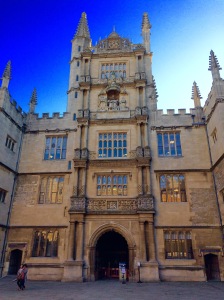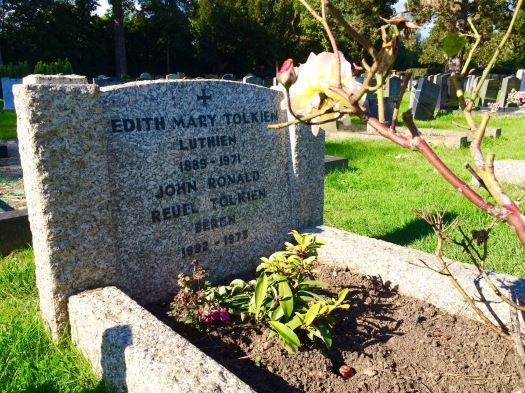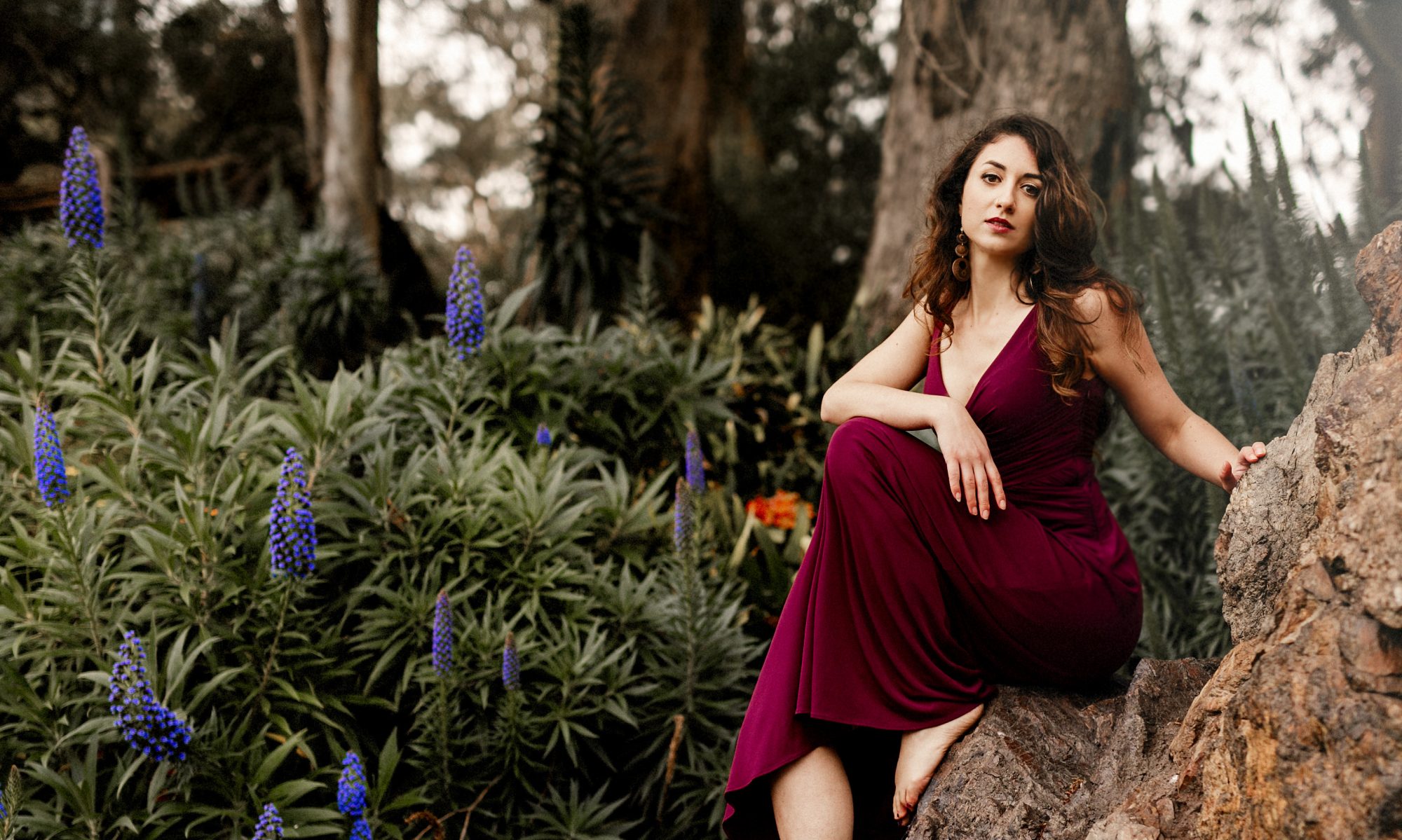
There is nothing quite like riding the train at magic hour, into the City of Dreaming Spires. I spent much of the day in London, including several important hours catching up with an old friend, having a fantastic brunch at The Breakfast Club in Soho, and walking through Hyde Park during the sunny, warm afternoon. As the day dwindled toward evening I walked from Warwick Avenue to Paddington Station, past canal boats floating low in the water covered in bright, chipping paint and overgrown planter boxes of flowers.
The departing sun set the sky alight in lavender, periwinkle, rose and indigo while the train sped toward Oxford. I chose to walk the mile and a half from the station to my lodgings in a friend’s college rooms so I could take in the city along the way. Sure enough I passed beneath the lit steeple of the University Church of St. Mary the Virgin, and not long after the tower at Magdalen College, where C.S. Lewis spent much of his teaching career. Crossing the bridge over the River Cherwell I could look back and see clearly why Oxford has been called the City of Dreaming Spires: the old college buildings send up spire after stone spire into the starry night air.
I arrived into my rooms which were warm and welcoming, filled with familiar books, including a shrine with Jung’s Red Book upon it. I found it somewhat amazing (although not surprising once I reflected on whose room I was occupying and our similar academic interests) that I had come halfway around the planet to study Tolkien’s visionary artwork, the contents of his Red Book, in the Bodleian Library, and right in my bedroom would be an accessible copy of the other Red Book to which I am comparing the results. It felt like an affirmation I was in the right place.

Early the following morning I awoke, soon to realize I was shaking—with anticipation, nerves, excitement, I wasn’t entirely sure. I planned to arrive at Admissions in the Bodleian at 9:00 am as they opened, and hopefully if all went well in getting my reader’s card I’d be meeting with the head archivist of the Tolkien special collection by 9:30. Walking through the streets of Oxford, down Queen’s Lane and under Oxford’s own Bridge of Sighs toward the library, I felt a deep sense of connection to this place. Ten years ago I once had the dream of attending this university, and now again that desire was reawakened. I could feel the past presence of those literary figures who had shaped me in such a formative way. Something in the heart of Oxford was calling to me once more.
I entered first the oldest building of the Bodleian, which had many doors branching off the courtyard with signs over their doors reading Schola Naturalis Philosophae and Schola Moralis Philosophae, among several others. Soon I was redirected toward the Weston Library, a newer building although still seemingly old to my eyes. I entered Admissions, handed in the various forms explaining my research purposes along with three (three!) forms of identification. To my relief I was approved without much delay but, before handing me my reader’s card, I was to swear an oath aloud that ran four lines long:
Then to the lockers where I left all my belongings except a pencil and blank sheets of paper, through the secure entryway, up the stairs and into the reading room. There I was met by the Tolkien archivist, a wonderful woman who has what I felt to be one of the most admirable and enviable positions in the library. We spoke for a little while about my research goals and then she set me up at a table with the first of four boxes of Tolkien’s artwork that I would be studying over this morning and the following.

My hands shook a little as I opened the first box, but I soon relaxed into the process, turning from one drawing to the next. What did I find there? Well, I’ve signed too many forms to risk revealing much here without the permission of the Tolkien Trust. But I’ll just simply say that I believe I found what I came for, that my thinking in these areas has been affirmed, and perhaps someday I will be able to express the fullness of what I saw in my dissertation. Much of Tolkien’s great art has been published already, for which I am immensely grateful. But a few pieces remain hidden which would be wonderful if they could be seen by the wider world. And the sequence itself of the artwork has its own story to tell.
After several hours and even more pages of notes I decided it was time for a change of scene, so I packed up and departed the library. I made a brief stop in Blackwell’s Bookshop, my favorite book store in the world that I hadn’t been inside of for about five years. Of course they had a whole Inklings section right up at the front, and I was able to get a copy of Verlyn Flieger’s edited edition of Tolkien’s fantastic essay “On Fairy-Stories,” first given in 1939 as the Andrew Lang lectures at the University of St. Andrews in Scotland. They also had lovely little editions of several of Tolkien’s short stories; I limited myself to two: Smith of Wootton Major and The Adventures of Tom Bombadil and Other Verses from the Red Book, each with accompanying introductory and critical essays.

Lunch at the Eagle and Child pub seemed the only appropriate place to go next, so I walked up St. Giles to the legendary “Bird and Baby,” and was soon sitting in the back room with a pint and vegetable pie, gazing at oil portraits of Tolkien and Lewis and scribbling notes on my morning’s research.
That afternoon I met up with a family friend who happens to be teaching in Oxford for the next two months, so we spent the next several hours catching up and discussing ideas on an array of topics, from philosophy and religion, to literature and travel. We walked home through Oxford in the evening together, conversation still well underway.
Morning found me once again in the Sir Charles Mackerras Reading Room, pouring over more drawings. But finally the time came for me to depart and I left with reluctance. Would I have the opportunity to again be a researcher in these halls? I hope my life may take such a turn.
For the afternoon I had a special pilgrimage planned: a long walk from Oxford city center first to 20 Northmoor Road, where Tolkien and his family lived seventeen years, and then on a few more miles up to the Wolvercote Cemetery where Tolkien and his wife Edith are buried beneath one gravestone. It felt important to me to walk, to really put in the time and effort and make it to each place on foot.

I noticed as I was walking down Northmoor Road I was shaking a little again. The wooden gate bears a metal number 20, and bushes and blackberry vines grow about the entrance. Someone else has made their home here now, and it looks simple and well-kept. The only distinguishing feature is a small blue plaque near the gable of the roof stating:
J.R.R. Tolkien
Author of The Lord of the Rings
Lived here 1930-1947
I tried to imagine what it might have been like to live here, raising four children, preparing lectures, marking exams, and writing thousands upon thousands of pages of fantasy and Elvish lexicons during some of the spare hours in between. I peered at the smaller house next door, number 22, where the Tolkiens had lived for a shorter period before, from 1926 to 1930. Eventually I continued on my way, grateful to have glimpsed these two homes.
The walk up to Wolvercote Cemetary was actually much longer than I expected, and a few times I thought I might be lost. I started to worry I wasn’t going in the right direction, or worse yet that I was but had somehow mistaken the cemetery and was walking far out of my way for nothing. I departed the road I had been on, thinking perhaps the cemetery was further east. I began to walk down an unfamiliar road when suddenly I had a strong sense to turn around. I did, and following intuition more than anything else I realized I was now on Banbury Road, the very road the cemetery was meant to be on. Sure enough just several hundred feet further, and a little sign pointed me into a wide, grassy cemetery. A brass plaque indicated to follow the signs to Tolkien’s grave. I had made it.
The Tolkiens are buried right near the back of the cemetery, a modest plot with a granite stone at the head and a rose bush with a few blooms, their fading petals marking the end of summer. The stone reads:
Edith Mary Tolkien
Luthien
1889-1971
John Ronald Reuel Tolkien
Beren
1892-1973
I cannot recount here all the emotions that arose in me at the sight of this grave. I’ll simply say it was a deeply meaningful experience, far more than I was even expecting. I spent a long time there. At one moment a strong wind picked up, shaking the trees. I was reminded of when the wind blew through the trees as Tolkien and Lewis were on Addison’s Walk by Magdalen College, the night that Lewis had his conversion experience, which Tolkien commemorated in his poem “Mythopoeia.” Finally I felt it was time to depart. As I turned away I saw a small, pure white feather on the ground. Rarely do I collect tokens of remembrance, but this time I felt the feather was for me.

It was a joy to rest my feet as I sat on the upper deck of the bus back toward city center, right at the front window so I could see clearly the whole return journey. I felt in a place of great peace. Arriving back into the heart of Oxford, I walked over to Exeter College, where Tolkien studied as an undergraduate, and was able to enter with my newly acquired reader’s card. (“I’m a visiting researcher, may I enter the college?”) Passing the emerald green quad I entered first the chapel, where a tapestry of the Adoration of the Magi adorned the front left-hand wall. A copper bust of Tolkien stood near the back, not too far from the door. Although small, Exeter’s chapel is exquisite. From there I somehow found myself in the Fellows’ Garden, a peaceful lawn bathed in sunlight, trees and flowers scattered throughout, a large fig climbing the stone wall by the private college library. Toward the back right of the garden is a small pond filled with water lilies, and a stone staircase ascending the outer wall of the college. Coming to the top of the stairs I found myself with a spectacular view looking out toward the round Radcliffe Camera, the tower of the University Church just beyond it. Below me a crowd of tourists happened to be walking by, but up here on the wall of Exeter College I was secluded, in the peace of an idyllic garden where generations have come to study outside.

After Exeter I went on to visit two more colleges: Christ Church College, which is by far the largest and wealthiest, with vast meadows stretching beyond it, and Magdalen, where C.S. Lewis was situated. Walking down the echoing corridor beside the Magdalen quad I had an internal image of black-robed students walking down these same halls, when suddenly I turned a corner and a whole choir of schoolboys in the very black robes I had been imagining processed down the passageway before me, turning quickly (and the smallest ones in the back shoving each other) into an arched doorway to the left. My footsteps carried me further until I passed out of the wrought-iron gates and across the small bridge over the River Cherwell onto the pathway of Addison’s Walk. Turning left I walked for a ways beside the river, stopping when I came to the next bridge and seeing to my right in the meadow a large herd of deer. All of the females and fawns were standing eating grass, while the two males with antlers—one significantly larger and presumably older than the other—sat on the ground on either side of the herd. After a moment in quiet reflection beside the deer, I turned back the way I’d come. I noticed a few things I had missed on the way in: a few large stumps that had been carved into thrones rooted directly into the ground, and a small moored boat that looked like it must belong to Ratty from Wind in the Willows.

By now completely exhausted from all my walking, I returned to the University Church which had a garden café at the bottom, and sat with a perfect cup of English tea and a scone, replete with clotted cream and strawberry jam. Just refreshed, I went to meet the same family friend I had joined the afternoon prior and we walked together over to Christ Church chapel to attend Evensong. It’s one thing to tiptoe into the college chapels when no one is there and take in the art and carvings on the walls, it’s another to come in when candles are lit and the air vibrates with the voices of young men and boys in the choir.
Thus, after a beautiful dinner and evening, my time in Oxford was coming to a close. The following morning I packed everything up and walked back toward the train station the same way I had walked in. An autumn mist had descended on the city, turning the morning Sun’s light into diffused rays that scattered across the yellow stones and fading trees. I felt a reluctance to leave this place. But if I am meant to return to the dreaming spires at some point in the future then I must trust that I will.




Wow Becca, thank you so much for writing all of this down. I envy your pilgrimage to those spots, not just because you were able to do it but because you have enough interest in him and his works to propel you down that road. I would have felt a hallowed sense in some of those places as well, but don’t have the extensive knowledge on them to take me there as you do. I am so touched to find out that he has labeled he and his wife Luthien and Beren on they tombstones, and can only image what that moment was like for you. Possibly the best love story of all time brought to life for a bit…
Your writing makes your journey come alive and I feel as if I can see all these beautiful, enchanted places though your eyes. So many lovely synchronicities and intuitively guided choices indicate you are on your best path. A future return will be there if you wish for it! Thank you for sharing your experiences and your gorgeous writing with us!